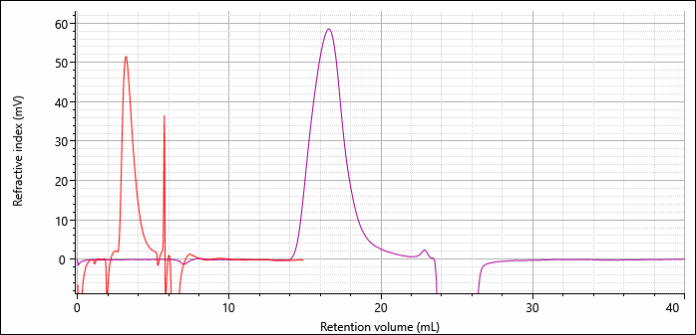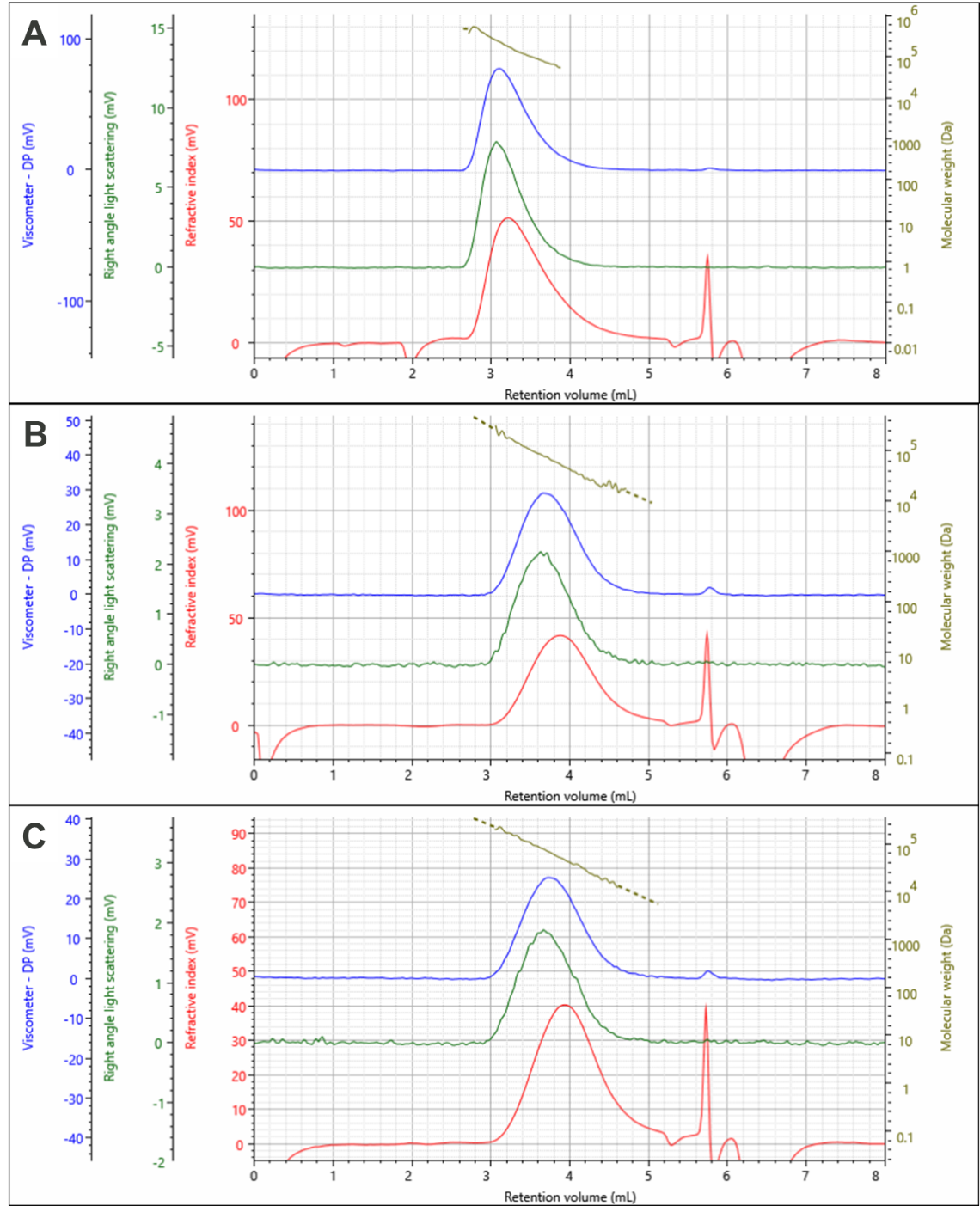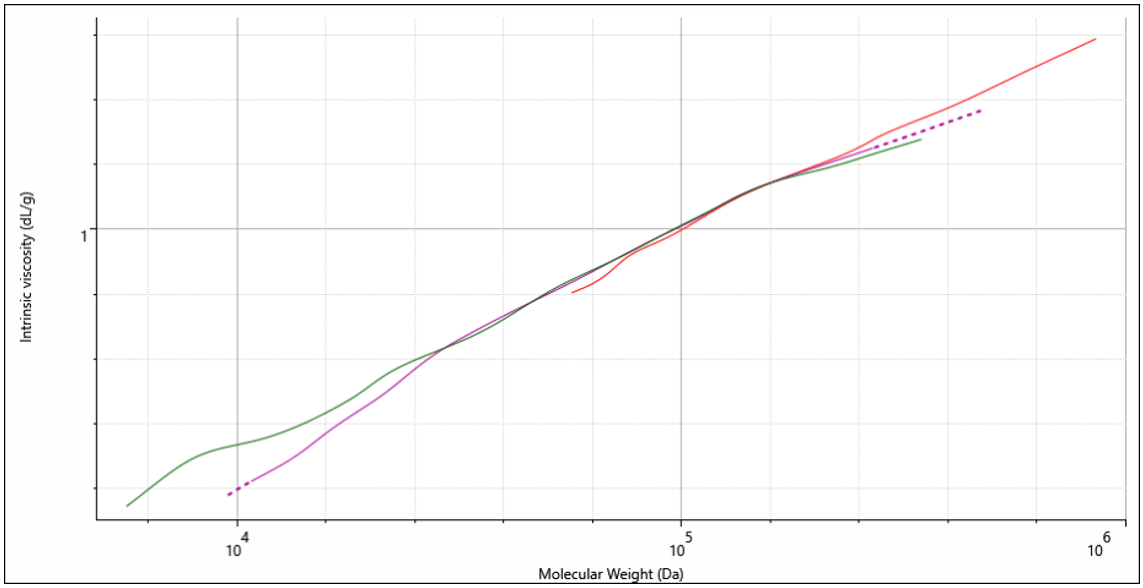Size-exclusion chromatography (SEC), also known as gel-permeation chromatography (GPC) is a well-known and widely used tool for measuring polymer molecular weight. Multi-detector SEC measurements including refractive index (RI) and light scattering (LS) can measure absolute molecular weight, independent of a molecules shape, structure, chemistry, or conformation. Polymer concentration is measured by the RI detector alone. The addition of a viscometer allows the measurement of intrinsic viscosity (IV), which is used to study conformation and branching, and can expose any structural changes that the polymer may undergo.
Typical analytical SEC measurements can take approximately 25 to 45 minutes and consume 25 – 45 mL of mobile phase. This is time-consuming and can be expensive if working with organic solvents. Ultra- performance liquid chromatography (UPLC) systems use novel SEC column technologies with robust, small particles (<2 µm) to achieve better sample resolution using smaller columns. This increases productivity, while significantly reducing run-time and cost. An additional benefit of the reduced solvent use is to effectively make UPLC a ‘greener’ technology than traditional analytical SEC.
The combination of multi-detector SEC and UPLC has, up to now, been challenging due to the significance of inter-detector band broadening (or dispersion); however, the latest developments in integrated multi-detector systems allows up to four detectors to be connected to UPLC systems with only a minimal loss of resolution due to band broadening.
In this application note, Malvern Panalytical’s OMNISEC REVEAL multi-detector module was combined with a Waters ACQUITY™ APC™ system to offer the best of both worlds; high resolution-rapid multi-detector SEC characterization of a PLA-PEO-PLA drug delivery polymer. The molecular properties of a virgin sample were compared with two samples sterilized by radiation.
Drug delivery is a large and growing research area including the use of both synthetic and natural polymers. Various polymers are being used in different ways to conjugate or contain small and large molecule drugs to release at a specified rate. Complexes of polymer and drug are used to tailor release rates, achieve targeting, and improve half-life all to modulate the efficacy of the drug as a therapeutic. Defining the release profile of the drug is a critical parameter which relies in part on the degradation characteristics of the polymer. Polymers such as PLA (poly-lactic acid), PEO (poly-ethylene oxide), and polycaprolactone are commonly used in these applications thanks to their biocompatibility and biodegradability.
In order to maximize the effectiveness of these drug-delivery polymers, their underlying molecular properties must be well-controlled as these will strongly impact their performance. Properties such as molecular weight, dispersity, and branching or conformation will all affect polymer degradation, and thus drug release and bioavailability. The properties must be measured for the virgin polymer and subsequent products made from it as the various processes undergone by the polymer will likely affect final properties. For example, any polymer to be used as a drug delivery implant will need to be sterilized by one or more potentially damaging treatments before clinical use.
Size-exclusion chromatography (SEC), also known as gel-permeation chromatography (GPC) is a well-known and widely used tool for measuring polymer molecular weight. Multi-detector SEC measurements including refractive index (RI) and light scattering (LS) can measure absolute molecular weight, independent of a molecules shape, structure, chemistry, or conformation. Polymer concentration is measured by the RI detector alone. The addition of a viscometer allows the measurement of intrinsic viscosity (IV), which is used to study conformation and branching, and can expose any structural changes that the polymer may undergo.
Typical analytical SEC measurements can take approximately 25 to 45 minutes and consume 25 – 45 mL of mobile phase. This is time-consuming and can be expensive if working with organic solvents. Advanced Polymer Chromatography™ (APC™) systems use novel SEC column technologies with robust, small particles (<3 µm) to achieve better sample resolution using smaller columns. This increases productivity, while significantly reducing run-time and cost. An additional benefit of the reduced solvent use is to effectively make APC a ‘greener’ technology than traditional analytical SEC.
The combination of multi-detector SEC and APC has, up to now, been challenging due to the significance of inter-detector band broadening (or dispersion); however, the latest developments in integrated multi-detector systems allows up to four detectors to be connected to APC systems with only a minimal loss of resolution due to band broadening.
In this application note, Malvern Panalytical’s OMNISEC REVEAL multi-detector module was combined with a Waters ACQUITY™ APC™ system to offer the best of both worlds; high resolution-rapid multi-detector SEC characterization of a PLA-PEO-PLA drug delivery polymer. The molecular properties of a virgin sample were compared with two samples sterilized by radiation.
The three polymer samples were dissolved in THF and separated on a Waters ACQUITY APC containing 3 ACQUITY APC-XT columns with pore sizes of 45, 125, and 450 Å. The three columns were all 4.5 x 150 mm. The mobile phase was THF.
The column eluent flowed directly into a Malvern Panalytical OMNISEC REVEAL module containing RI, UV-Vis, LS, and IV detectors connected in series. The detectors were calibrated using a NIST-traceable polystyrene molecular weight and intrinsic viscosity standard.
Figure 1 shows a comparison of analytical SEC with UPLC. The time and mobile phase saving per injection is clearly visible.

Figure 1: Overlaid chromatograms of the virgin polymer showing the UPLC (red) and analytical SEC (purple).
Figure 2 shows the multi-detector chromatograms for the three samples, the virgin and two irradiated PLA-PEO-PLA polymers. The chromatograms and separations are of high quality and differences between the samples are clearly visible.

Figure 2: Multi-detector UPLC chromatograms of the virgin (A), irradiated 1, and irradiated 2 (B & C) samples showing RI (red), light scattering (green) and viscometer (blue) signals. The measured molecular weight across the peak has been overlaid (gold)
Table 1 shows the numerical results from these analyses. The differences between the samples are very clear and the degradation in the irradiated samples is clearly significant. The molecular weight of the polymer has reduced by approximately two-thirds or more. The intrinsic viscosity and hydrodynamic radii of the polymer samples are also significantly reduced.

Table 1: Molecular weight and intrinsic viscosity data for the three polymer samples.
Figure 3 shows Mark-Houwink plots for the three polymer samples. A Mark-Houwink plot shows intrinsic viscosity as a function of molecular weight. Any polymer with a distribution of molecular weights is represented as a line on the plot. A change in the gradient of the line is related to the way chains are added to the polymer backbone, a branched or cross-linked polymer is expected to have a lower gradient. A shift in the intercept with the y-axis represents differences in the density of the backbone structure of the polymer, typically this is seen when different polymer chemistries are compared. In this case, the Mark-Houwink plots for the three samples overlay well suggesting no structural differences between them. The conclusion that can be drawn from this is that the polymer degradation is a result of simple polymer scission and not a more complicated mechanism.

Figure 3: Overlaid Mark-Houwink plots for the three polymers showing virgin (red), irradiated 1, and irradiated 2 (purple and green) samples.
The combination of Waters ACQUITY APC and OMNISEC REVEAL make for an extremely powerful polymer characterization tool. The multi-detector component allows for a high level of characterization, including the measurement of absolute molecular weight, independent of the polymer’s chemistry or structure, and also a direct measurement of any structural changes that occur. When combined with a APC system, these measurements can be performed with improved resolution, reduced sample loading and in shorter times. This increases productivity reduces the cost of these kinds of studies, and can be considered ‘greener’ thanks to their reduced solvent usage.
In this note the degradation of a PLA-PEO-PLA drug delivery polymer was characterized. Irradiated samples were seen to have dramatically reduced molecular weight but no changes in their conformation or structure implying that this degradation was due to polymer scission caused by the radiation. This type of analysis is made possible due to the unique combination of high resolution separation using the APC with a true multi-detection system, containing not only light scattering detectors but also an online differential viscometer to measure structure.